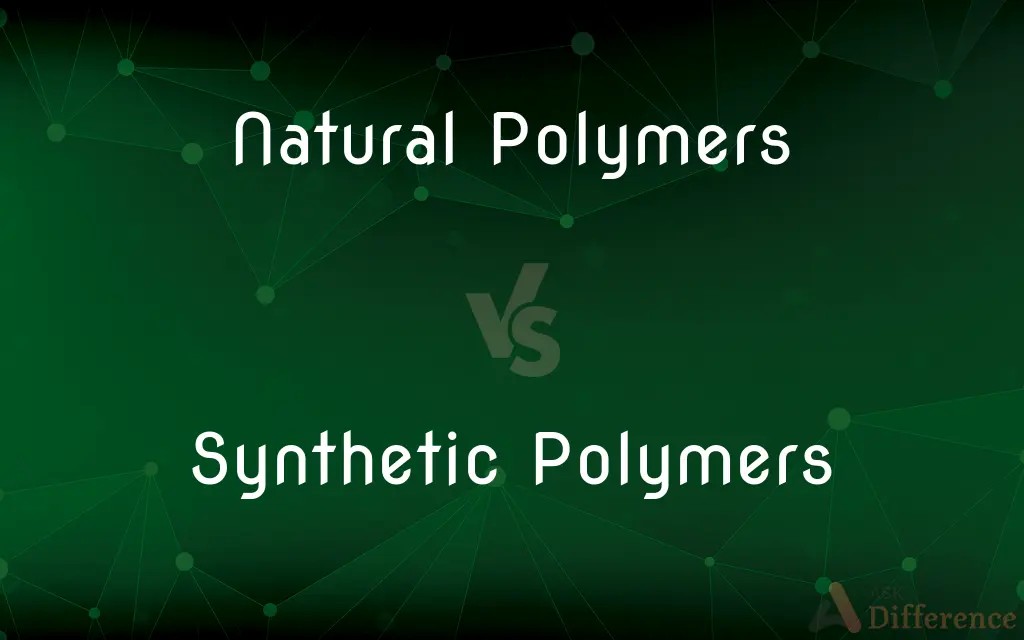Natural Polymers vs. Synthetic Polymers — What's the Difference?
Edited by Tayyaba Rehman — By Fiza Rafique — Published on December 14, 2023
Natural Polymers originate from nature; Synthetic Polymers are man-made. Both are macromolecules, but their sources and properties differ.

Difference Between Natural Polymers and Synthetic Polymers
Table of Contents
ADVERTISEMENT
Key Differences
Natural Polymers are large molecules derived from living organisms. They play vital roles in the biology of life, like DNA, proteins, and cellulose. On the contrary, Synthetic Polymers are artificially created in laboratories and industries, such as nylon or polyester. Both types have unique molecular structures based on their origin.
Natural Polymers are biodegradable due to their origin from living organisms. Examples include silk, wool, and rubber. Synthetic Polymers, however, are often non-biodegradable and can persist in the environment for a long time, like plastics. The sustainability of Natural Polymers is usually higher than that of Synthetic Polymers.
Natural Polymers often display a broad range of properties within a single category, stemming from their biological origin. Synthetic Polymers, on the other hand, can be engineered to have precise properties, tailored for specific applications. Both can be processed and modified, but Synthetic Polymers offer more control over end properties.
Natural Polymers are directly obtained from renewable resources and usually involve minimal processing. In contrast, Synthetic Polymers are derived from petrochemicals and often require extensive industrial processes. Both types of polymers play essential roles in modern society, with Natural Polymers being preferable for sustainability and Synthetic Polymers for versatility.
Natural Polymers have been used by humans for thousands of years in various applications, like clothing and shelter. Synthetic Polymers, though newer, have revolutionized industries, from textiles to electronics. Both have significantly impacted human civilization, with Natural Polymers being traditional and Synthetic Polymers being modern.
ADVERTISEMENT
Comparison Chart
Origin
Derived from nature
Man-made in labs or industries
Biodegradability
Typically biodegradable
Often non-biodegradable
Range of Properties
Broad within a category
Can be engineered for specific properties
Source
Renewable resources
Mainly from petrochemicals
Historical Usage
Used for thousands of years
Revolutionized industries in the last century
Compare with Definitions
Natural Polymers
Natural Polymers are typically biodegradable compounds.
Cellulose, a Natural Polymer in plant cell walls, decomposes in nature.
Synthetic Polymers
Synthetic Polymers revolutionized various industries.
Nylon, a Synthetic Polymer, transformed the textile industry.
Natural Polymers
Natural Polymers have been utilized by humans for millennia.
Wool, a Natural Polymer, has been used for clothing for ages.
Synthetic Polymers
Synthetic Polymers can be tailored for specific properties.
Teflon, a Synthetic Polymer, is designed for non-stick applications.
Natural Polymers
Natural Polymers often require minimal processing for use.
Rubber, a Natural Polymer, is directly tapped from trees.
Synthetic Polymers
Synthetic Polymers often originate from petrochemicals.
Polyester, a Synthetic Polymer, is derived from petroleum.
Natural Polymers
Natural Polymers are macromolecules derived from living organisms.
DNA is a Natural Polymer essential for storing genetic information.
Synthetic Polymers
Synthetic Polymers can persist in the environment.
PVC, a Synthetic Polymer, is known for its durability and long lifespan.
Natural Polymers
Natural Polymers are sourced from renewable materials.
Silk, a Natural Polymer, is produced by silkworms.
Synthetic Polymers
Synthetic Polymers are artificially created large molecules.
Polyethylene, a Synthetic Polymer, is used in plastic bags.
Common Curiosities
Are all Natural Polymers biodegradable?
Most Natural Polymers are biodegradable, but it can vary based on conditions.
What are Natural Polymers?
Natural Polymers are large molecules sourced from nature, often from living organisms.
What are the primary sources of Synthetic Polymers?
Synthetic Polymers are mainly derived from petrochemicals.
Are there environmental concerns with Synthetic Polymers?
Yes, many Synthetic Polymers are non-biodegradable, leading to environmental issues like pollution.
How are Natural Polymers extracted?
Natural Polymers are directly obtained from nature, like tapping rubber from trees.
How do Synthetic Polymers differ from Natural Polymers?
Synthetic Polymers are man-made, while Natural Polymers are derived from nature.
Can Synthetic Polymers be made biodegradable?
Yes, some Synthetic Polymers can be engineered to be biodegradable.
Why are Synthetic Polymers prevalent in modern industries?
Synthetic Polymers offer versatility, durability, and can be tailored for specific properties.
Why are Synthetic Polymers often non-biodegradable?
Synthetic Polymers are engineered for durability, making them resist natural decomposition.
Which is more sustainable: Natural Polymers or Synthetic Polymers?
Generally, Natural Polymers are more sustainable, being sourced from renewable resources.
How have Natural Polymers impacted human civilization?
Natural Polymers, like wool and silk, have been used by humans for various purposes for millennia.
Do Natural Polymers vary widely in properties?
Yes, Natural Polymers can display a broad range of properties within a category.
Can Synthetic Polymers mimic the properties of Natural Polymers?
Yes, Synthetic Polymers can be engineered to have similar properties to Natural Polymers, like synthetic rubber.
Can Synthetic Polymers be recycled?
Many Synthetic Polymers, like certain plastics, can be recycled with appropriate facilities.
Which is more expensive: Natural Polymers or Synthetic Polymers?
Costs vary, but often, Synthetic Polymers are cheaper due to mass production and consistent properties.
Share Your Discovery

Previous Comparison
Unified Memory vs. RAM
Next Comparison
Olay vs. No 7Author Spotlight
Written by
Fiza RafiqueFiza Rafique is a skilled content writer at AskDifference.com, where she meticulously refines and enhances written pieces. Drawing from her vast editorial expertise, Fiza ensures clarity, accuracy, and precision in every article. Passionate about language, she continually seeks to elevate the quality of content for readers worldwide.
Edited by
Tayyaba RehmanTayyaba Rehman is a distinguished writer, currently serving as a primary contributor to askdifference.com. As a researcher in semantics and etymology, Tayyaba's passion for the complexity of languages and their distinctions has found a perfect home on the platform. Tayyaba delves into the intricacies of language, distinguishing between commonly confused words and phrases, thereby providing clarity for readers worldwide.
















































